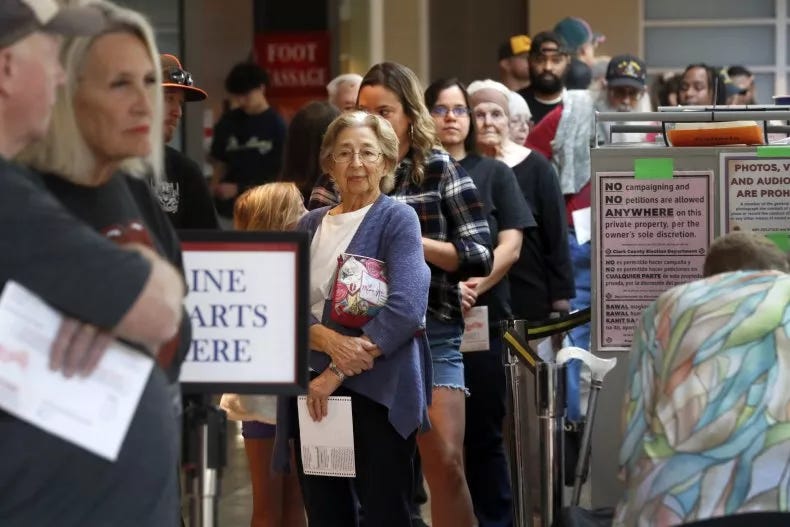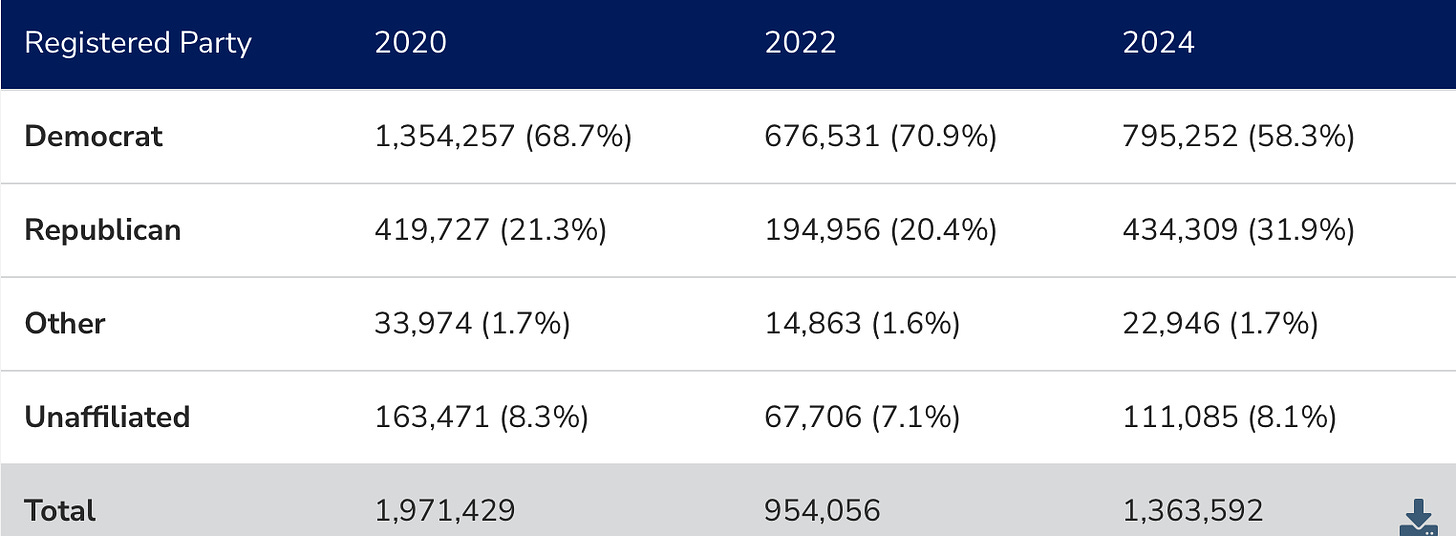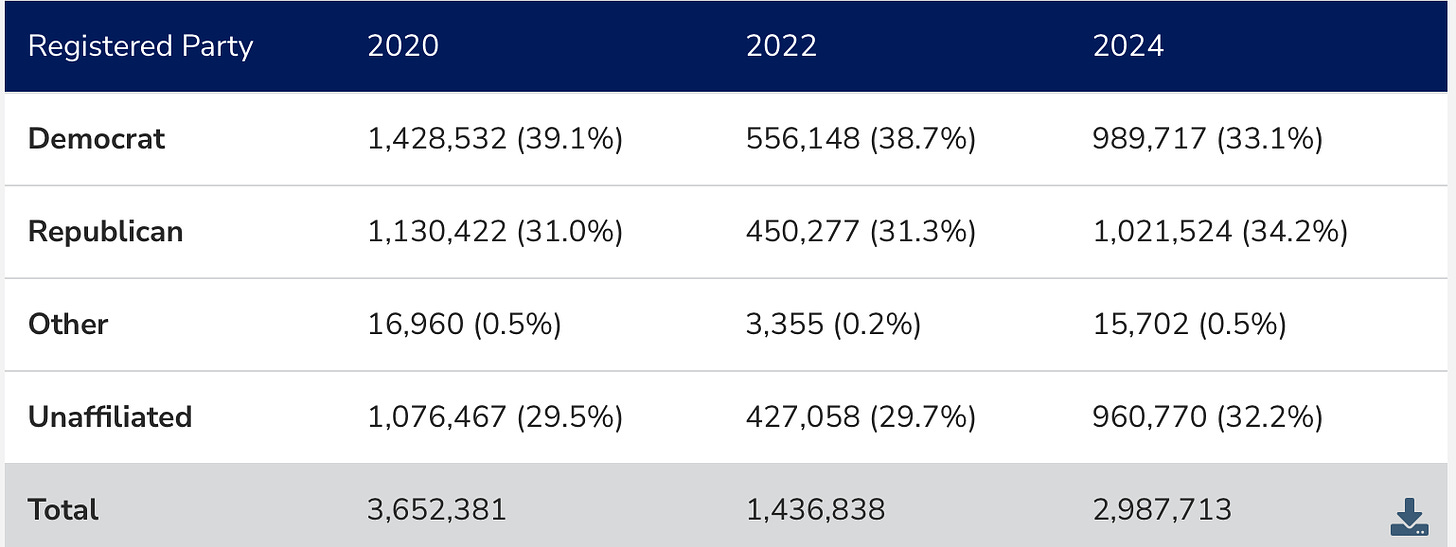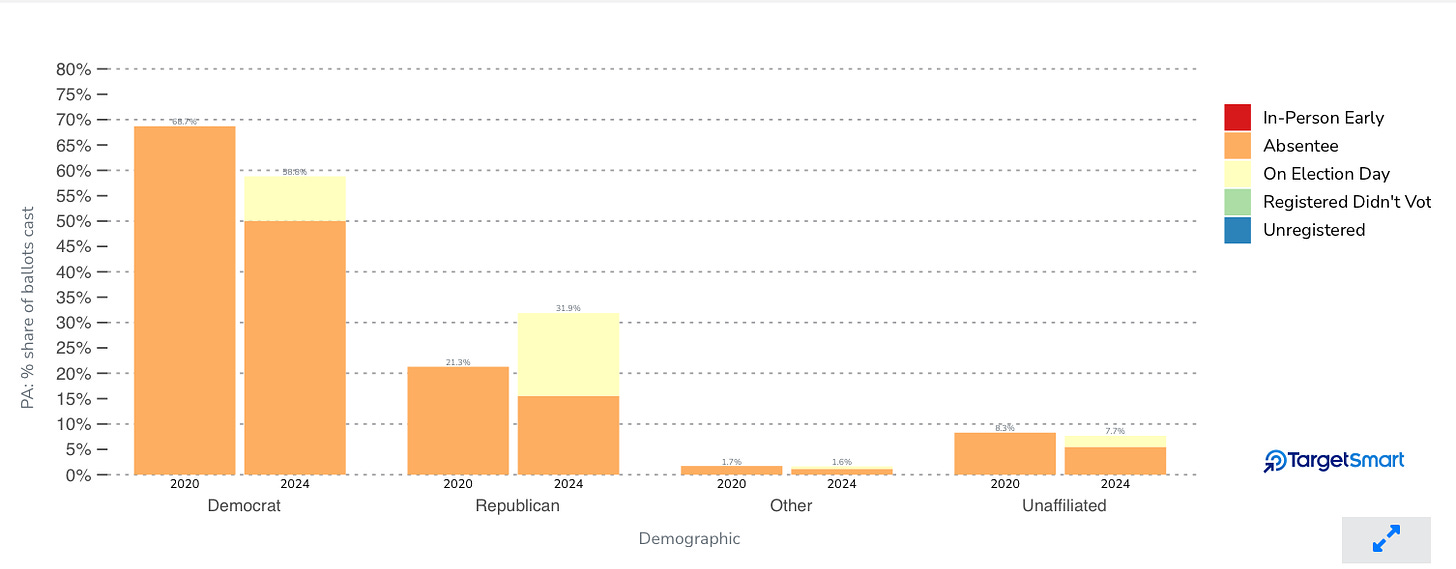The Early Vote Looks Very Female
The enthusiasm among early women voters across the battlegrounds is good news for Harris.
The more I delve into the numbers, the more I believe that this election is still about that big gender gap. As I noted in my piece on about the early vote in The Big Picture last week, there are two somewhat contradictory trends worth examining.
First, as has been widely reported, the number of early Democratic voters has fallen off sharply relative to 2020. This is because more Democrats are electing not to vote early this year. Meanwhile the number of Republican voters has been rising compared to 2020 as GOP efforts to get them to bank their votes has had some modest effect. We shouldn’t freak out over this. Nearly all of those Democratic voters will still show up on Election Day. But it does significantly skew the early vote by party registration numbers. In Pennsylvania, for example, that shift has resulted in around a 10 point gain for Republicans in the early vote percentage compared to 2020, with Democrats seeing around a 10 point loss. Again, this is expected and not a huge concern.
That’s because of the second thing I’m seeing. Somewhat surprisingly, the percentage of women early voters has still remained the same across recent elections, even though the mix of the political parties among the early voters has shifted strongly. Looking again at Pennsylvania, the gender make-up of the electorate has hardly changed at all, despite the sharp drop in Democratic early voters and the rise among Republicans.
In today’s piece, I’ll explain why the numbers feel contradictory and point to trouble for Trump because of sustained enthusiasm among women voters. I’ll also show that Trump’s efforts to turn out large numbers of low-propensity male voters in response isn’t working, at least so far. I’ll end with what those two things mean for Election Day, and why I remain cautiously optimistic.
A curious contradiction
Here’s a more detailed breakdown of why my eyebrows are a bit raised by these numbers. Typically, around 60 percent of Democratic voters are women, but only around 52 percent of Republican voters are. A lot fewer Democrats voting should mean that the percentage of women voters drops off, too. But we haven’t seen that at all.
That implies the gender gap remains the story of this election. The GOP had hoped that the Dobbs effect—which has turned out women voters in large numbers and shifted races toward the Democrats by several points in special elections ever since June of 2022—would be played out by now. But that doesn’t seem to be the case.
Politico was out with a story on the gender gap today, and the analysis comports with my own from last week.
Across battlegrounds, there is a 10-point gender gap in early voting so far: Women account for roughly 55 percent of the early vote, while men are around 45 percent, according to a POLITICO analysis of early vote data in several key states. The implications for next week’s election results are unclear; among registered Republicans, women are voting early more than men, too. But the high female turnout is encouraging to Democratic strategists, who expected that a surge in Republican turnout would result in more gender parity among early voters.
Tom Bonier of TargetSmart agrees that some of the data are genuinely surprising, given the uptick in Republican early voting. “In some states women are actually exceeding their vote share from 2020, which is at this point shocking to me,” said Bonier. “I never would have bet on that.”
A closer look at North Carolina
Republicans have been cheering the fact that their early vote numbers in the Tar Heel State now exceed those of the Democrats. Isn’t this a sign Harris is in trouble? Here is how Republicans have surged ahead in just four years to actually outnumber Democrats in early voting:
Before you get heartburn from this shift, take a look at the gender gap in the state, which is in the chart below. Again, if so many more Republicans are voting early, that gap should have shrunk considerably from 2020, right? But that’s not what’s happened at all. It has barely budged.
If gender winds up correlating with final results, Trump needs to have cut early into that gender gap with his surge of GOP voters. That’s because there are still around half a million fewer Democrats who have voted early so far in 2024 compared to 2020. If nearly all those voters show up on Election Day, Trump’s job of narrowing that gender gap becomes much harder.
Suburbia is where it’s at
The gap between the genders appears to be driven primarily by a surge in support for Harris among suburban women. As readers here know, I prefer to look at movements within polls over time, rather than point to any absolute numbers, to gauge any significant trends. And we see it with this group. For example, a recent ABC/Ipsos poll has Harris with a 19 percentage point lead among suburban women—a very big number—that importantly is up 10 points from earlier.
At the same time, according to Politico, “Harris has cut Trump’s 27-point margin of victory in 2020 with white women without a college degree in half, a recent Marist Poll shows.”
But what about the bros?
Trump has gambled that he can reach low-propensity male MAGA voters by targeting them on podcasts, streaming and other non-traditional media. But so far, they haven’t shown up in the early vote. Trump will need them to turn out in huge numbers on Election Day to make up the gap.
Let’s take a deeper look again at Pennsylvania and North Carolina, both of which have great party registration and gender data broken down.
In Pennsylvania among “first time male voters,” Trump hasn’t convinced more of them to vote early compared to 2020 at this same point, seven days out from the election. Their numbers look about the same as a percentage from that election to this one.
The gap looks even starker in North Carolina. Here is the early vote breakdown between the genders in North Carolina from “first time” voters.
That’s right! Women have actually improved on the 2020 numbers by 4.2, while men have slacked off by 1.3 points.
Moving up the ladder, among “infrequent voters” who have cast early ballots in Pennsylvania, women are outpacing their 2020 and 2022 numbers percentage-wise, while men are somewhere in between the numbers for those years. We just haven’t seen any bump above normal numbers for the Pennsylvania guys so far, even though there are far fewer Democrats voting early and more Republicans on the whole.
Same goes for infrequent voters in North Carolina. Nothing Trump has done has caused infrequently voting men to show up early in bigger numbers, even though there are a lot more Republicans voting early. If anything, they have dropped back a bit while women have made small gains.
Is the GOP cannibalizing from its Election Day vote?
The early vote among Republicans in Pennsylvania doesn’t just look like it’s coming from more frequent voters. It also appears to be largely cannibalizing from people who voted on Election Day in 2020.
This chart shows the relative percentage of “cannibalization” of Election Day votes by early mail-in votes in Pennsylvania. As you can see, more than half of the early vote by Republicans is drawing from those who voted on Election Day in 2020 (shown in yellow). This means relatively fewer Republicans remain in the pool of Election Day voters, while a lot more Democrats still remain.
Where does that leave things come Election Day?
For Trump to prevail in a battleground state like Pennsylvania, where he lost in 2020 by over 80,000 votes, one of two things would have to happen. Either he needs to find a lot of new voters to turn out for him, or a lot of Democrats would have to stay home.
The early vote indicates that, at least so far, there isn’t a lot of enthusiasm among new male voters, while women voters are still turning out in numbers that will place a high burden on the Trump campaign on Tuesday. Moreover, there are hundreds of thousands more Democrats who will vote on Election Day this year than in 2020, so the effect of the “red surge” mathematically cannot be as pronounced.
The final gender gap in Pennsylvania in 2020 was 5.8 points, and Trump lost the state. The current early vote gender gap in Pennsylvania is 12.5 points, a level comparable to where we were in 2020 and 2022 at this time but with a lot more Democratic votes still yet to come on Election Day than before. Otherwise put, Trump needs to close a similar gap with a lot fewer voters than he had in 2020. I like where this puts us in this state.
The same logic applies to North Carolina, though Harris would need to move that state’s numbers from a loss in 2020 by around 74,000 votes in order to eke out a win.
Is it possible that men could rally and turn out in big enough numbers on Election Day to erase the early women vote advantage? Sure. But enthusiasm to vote tends to show up not only in the polling but in the actual early voting numbers, especially if there really are first time or infrequent voters who are eager to have their say. As I showed above, these voters have not yet materialized for Trump.
We’ll see if they do in these remaining days of early voting, and of course on Election Day. But I’m sure the Trump folks wish they had managed to close the gender gap with all of these early GOP voters. Their failure to do so will be a problem for Trump as we head into the final days of this contest.















(wipes some sweat off brow) Thanks, Jay, I needed that this morning.
I talked a "bro" yesterday into voting for Kamala. He's a gamer type. He was undecided. When he told me that, I initially wanted to sedate him for the next week, but when he displayed a remarkable lack of knowledge about everything, I explained to him how tariffs would impact his next monitor purchase (he goes through monitors like some of us go through Keurig coffee pods).
He was like, "No way, dude." Followed by a few expletives. Then he said he's voting for Kamala.
I attended the Harris/Obama/Tyler Perry/Springsteen et al rally in Clarkston Ga last week. I'm a white 74 year old female with a PHD. I'd say the crowd of 24,000 was relatively evenly split along race and gender lines. And I'll tell you what struck me.... no matter what speaker mentioned it, and every one of them did, when reproductive freedom was brought up? The crowd went nuts. It matters in this race.